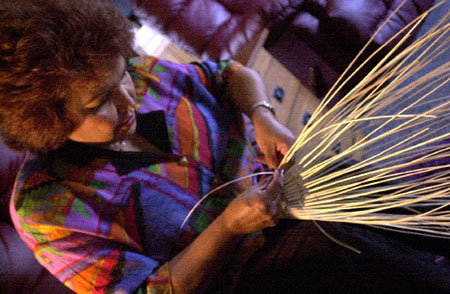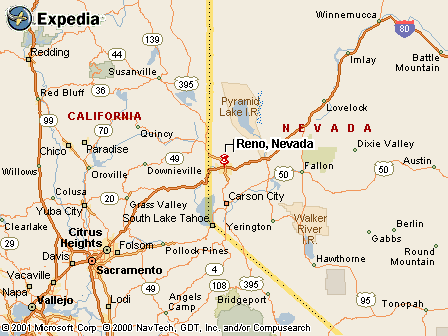|
|
Canku Ota |
|
|
(Many Paths) |
||
|
An Online Newsletter Celebrating Native America |
||
|
January 11, 2003 - Issue 78 |
||
|
|
||
|
Coleman Keeps Washoe Spirit Alive Through Weaving |
||
|
by Sandi Wright Reno
Gazette Journal
|
||
|
credits: Lisa J.Tolda
Reno Gazette Journal
|
 Keeping
the spirit of the Washoe Indian Tribe alive is what keeps Sue Coleman’s
passion for basket weaving fresh and focused. Keeping
the spirit of the Washoe Indian Tribe alive is what keeps Sue Coleman’s
passion for basket weaving fresh and focused. “It’s a very spiritual thing for me,” the 52-year-old woman said. “I was raised in Dresslerville on the reservation,” Coleman said. “My mother was one of the spiritual leaders in our tribe. People would come to her for prayer. “She had a passion for our traditions — how we collected, the fishing, the hunting, the gathering — and she got more and more into sharing that with me. But we don’t appreciate this when we’re younger.” It wasn’t until Coleman was in her thirties that the significance of her contribution to the survival of her culture became clear to her. “When I was young, all the women made baskets. They used them for everything. They had three baskets for their babies, so the babies stayed in them until they could walk. They cooked in them and they gave them away as gifts,” she said. “Later I realized that there were very few women still weaving. There were only about five elders in Dresslerville doing it, and I knew it was going to die out if I didn’t do something,” Coleman said. In addition to her status as a master Washoe willow weaver, Coleman teaches her craft and also gives cultural presentations to schools and community groups. “I’ve known Sue about four years, and one of the things that stands out about her is that she’s always pulling people together,” said Jeanne Harrah Johnson, folk-life program coordinator for the Nevada Arts Council. “She doesn’t only do this for the Washoe Tribe, but all tribes. She’s always encouraging them to preserve their culture,” Johnson said. In nominating her for the Governor’s Arts Award for 2002, her husband, C.J. Coleman, wrote, “She has made it her passion to share this knowledge throughout Nevada, California and Arizona to keep this art form alive.” Coleman’s willow basket weaving is considered among the finest traditional work of its kind. “She does some of the finest work I’ve ever seen. I am always amazed at the detail, the delicacy, the intricacy,” Johnson said. But exquisite basket-weaving skills didn’t come overnight. Coleman’s mother, Theresa Smokey Jackson, was awarded a grant from the Nevada Arts Council to teach Coleman the craft. “First I learned to gather willows and to strip threads. I went with my mother and my aunt and we’d take a lunch. You can only gather willows in winter when they’re dormant, so it was usually cold,” Coleman said. “Sometimes we’d go into California. Because of all the development and the spraying of chemicals, it’s hard to find good willows,” she said. Coleman said her first project was a cradleboard hood, adding, “You’re very rough when you’re starting out.” After a couple of years, Coleman stopped weaving to do other things. “We raised three children. My husband was a fireman. I was a very busy lady, and weaving just consumes so much of your time,” she said. Another reason many American Indian women don’t stick with the craft is the toll it takes on hands. “So many quit because it’s so rough on your hands. They are always in water because the threads have to be wet,” Coleman said. “Also, the house is always a mess because you’ve got willows everywhere,” she said. Then something happened about three years ago that renewed Coleman’s desire to preserve her native culture. Her mother died. “She called me one night and said her heart was racing, and she died the next day. It was so sudden, but I got to be with her that night, and I promised her that I would carry on the tradition she was so admired for, and I’ve been doing it ever since,” Coleman said. “I’ve probably made 50 or so baskets. Each one takes a long time to make — about a month, but I’m trying to do more traditional weaving because that’s what she wanted,” Coleman said. “I don’t work (outside the home), but I stay up until two in the morning sometimes working on my baskets. I love doing it, and I’m constantly learning,” she said. Coleman is passing along the art of willow basket weaving to her daughter, Cynthia Kannan, 32, in the traditional Washoe Indian way — mother to daughter. “My oldest daughter knows how to split a willow and make a thread. It took me more than a year to learn how to do that,” she said. In November, Coleman was awarded the Governor’s Award for Excellence in Folk Arts. Some of her work will be exhibited in February at the Nevada Arts Council office in Carson City. Coleman is doubly pleased by the award. “I
was so excited when I got that award because my mother got it seven
years ago. I feel that I am honoring her in that way,” she said.
|
|
|
||
|
|
||
| Canku Ota is a free Newsletter celebrating Native America, its traditions and accomplishments . We do not provide subscriber or visitor names to anyone. Some articles presented in Canku Ota may contain copyright material. We have received appropriate permissions for republishing any articles. Material appearing here is distributed without profit or monetary gain to those who have expressed an interest. This is in accordance with Title 17 U.S.C. section 107. | ||
|
Canku Ota is a copyright © 2000, 2001, 2002, 2003 of Vicki Lockard and Paul Barry. |
||
 |
 |
|
|
The "Canku Ota - A Newsletter Celebrating Native America" web site and its design is the |
||
|
Copyright © 1999, 2000, 2001, 2002, 2003 of Paul C. Barry. |
||
|
All Rights Reserved. |
||
